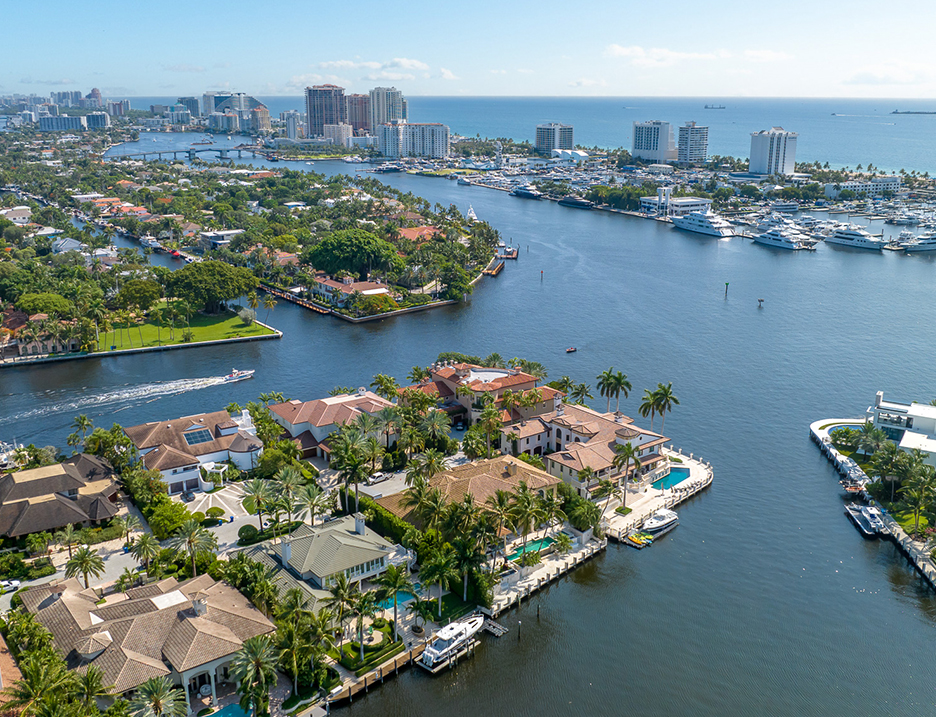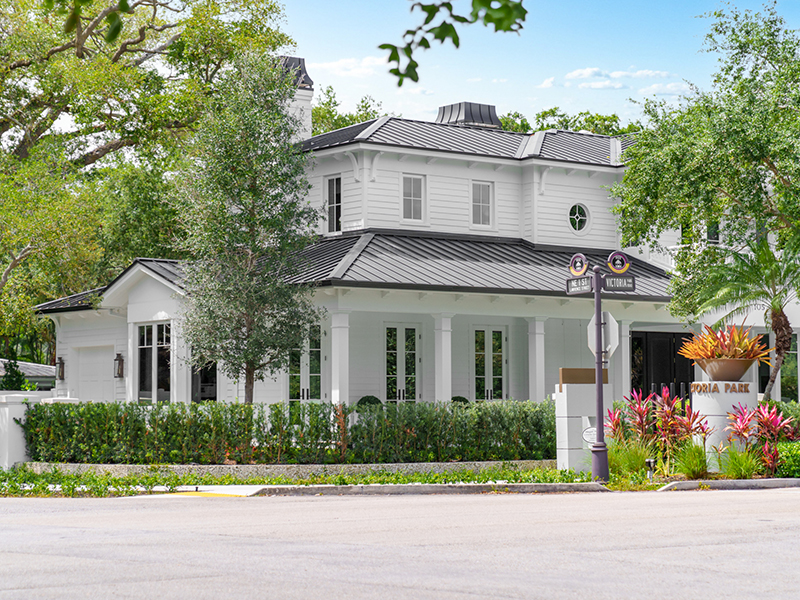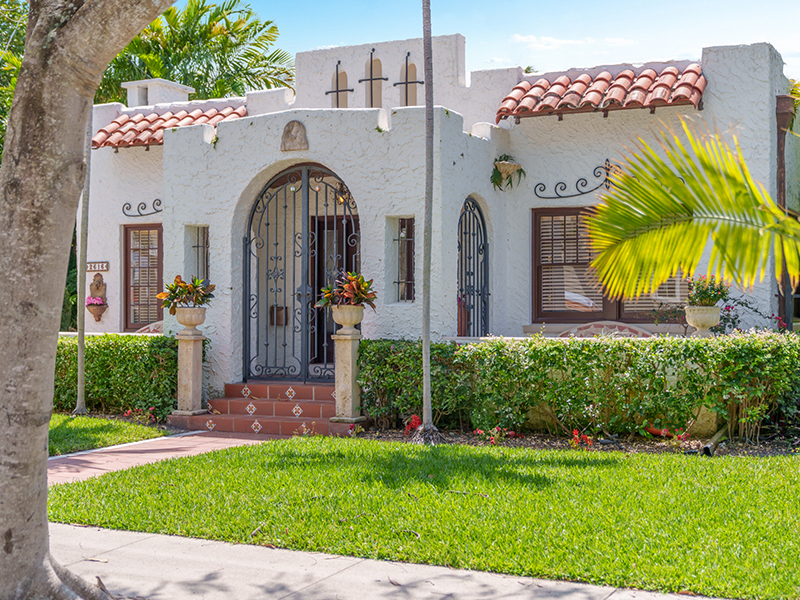
Victoria Park and Las Olas
Victoria ParkBeautiful, historically significant and inviting Victoria Park is sitting atop the edge of a prehistoric coastline on an ancient coral ridge, one of the oldest neighborhoods in our city. Victoria Park is home to many of our most beautiful tree-lined streets, homes, and landscapes, some of which continue to exemplify the style and character reflective of the time when this little subdivision was first “planned” back in the early to mid-1920’s. It has been said that approximately 30% of Fort Lauderdale’s historic homes can be found in this charming neighborhood. With Sunrise Boulevard as the north border, Broward Boulevard as the south, NE 20th Avenue at the east end and US 1 on the west side, Victoria Park is conveniently located adjacent to our city center, Fort Lauderdale.
To go back to the beginning, in the winters of 1894 & 1895 there were two very severe frosts virtually wiping out all of the orange groves to the north. It is told that either Mary Brickell or Julia Tuttle (or both); two of the largest landowners in the SE FL area thought it would be a good idea to send railroad magnet Henry Flagler some fresh orange blossoms to show him that the SE coastal area did not suffer the frost and loss of crops in the winter. They also wanted him to understand that their extensive land holdings would permit them to support a profitable freight operation year-round. Mr. Flagler was convinced and in March of 1896 he did bring the railway to Fort Lauderdale and on to Biscayne Bay in Miami, only one month later in April.
To protect the beautiful, pristine oak hammock and views of the waterway Mary Brickell insisted that Flagler route the railroad around the Victoria Park and Colee Hammock neighborhoods; just north of the New River bending about a mile to the west crossing the river just west of Andrews – a more “bridgeable” location. This action was key in preserving the beautiful, lush canopy of Victoria Park and the adjacent Colee Hammock neighborhood nestled between Las Olas and Broward Boulevards.Alfred G. Kuhn, Victoria Park’s developer, named his subdivision after his daughter Victoria, recording in public records the first dedication of land on July 11, 1925. He intended for his subdivision to be an enclave of exclusively residential real estate. The north boundary was NE 7th Street, the south boundary was Broward Boulevard, east was the Karen Canal and west was NE 14th and NE 17th Avenues. To make the homes and lots more interesting and appealing the original 24 blocks featured unusual curved and diagonal street patterns.
In early 1925 an addition was planned and added to the Victoria Park neighborhood and in 1926, Victoria Courts developed by Ralph Horton (now a designated historic district of darling cottages) was also included in Kuhn’s subdivision adding yet even more desirable real estate to Victoria Park. Today Victoria Park stretches a little over 1 square mile from US 1 on the west end to Lake Karen at the east end and from Broward Boulevard on the south to Sunrise Boulevard on the north.
In the 1930’s an apprentice of renowned architect, Francis Abreu – Morton T. Ironmonger, began designing Spanish Mission style homes in the neighborhood. Many of these wonderful homes are still standing today.
Mid-Century Modern architecture homes began to line the streets of this lush area after World War II ended. Families moved into the area and the neighborhood really began to flourish.
The growth and change is still ongoing at this time. It is said that one can identify at least one home (probably several) from each of the past 10 decades in this diverse and eclectic neighborhood.Residents and guests in beautiful Victoria Park can enjoy any one of 3 parks and the expertly reimagined Parker Playhouse/Auditorium, now called The Parker. The largest of the parks is Holiday Park – which consists of 93.44 acres of land and is home to the world class Chris Evert Tennis Center. There is plenty to do here with lighted athletic fields, full court basketball, fitness stations and a walking/jogging trail, a roller hockey rink, racquetball court, shuffleboard, volleyball court, football field, gymnasium, pickleball courts, concession stands, picnic areas, a dog park, a playground, restrooms, and plenty of wide-open areas to relax and enjoy the gorgeous south Florida outdoors. The two others are Victoria Park and Annie Beck Park, which while much smaller, both offer beautiful canopies, lush green space, and plenty of room to relax by a little tributary of the storied Middle River.
Victoria Park is proud to be home to two of our area’s top rated schools; St. Anthony which goes from PreK to Grade 8 and Virginia Shuman Young, from PreK to Grade 5. There is a very active civic association. The residents take great pride in this lovely enclave, exuding a true sense of community.
Homes in this wonderful neighborhood are a charming mixture from tiny “cracker box” cottages built in the early 1900’s, to a few of Spanish revival architecture, some fabulous mid-century modern ranchers, and newer, contemporary modern style homes, townhomes, and condominiums. There’s something for everyone here.
Las OlasLas Olas “The Waves”, perhaps the most easily recognizable name in the Fort Lauderdale area. This area, rich with history is “where it all began”. The beginnings of what we all know as Fort Lauderdale, the settlements and trading began right here along the New River. In the mid 1890’s, commerce began to flourish with the ferry that was established to take folks and their goods across the New River. Initially operated by Edward Moffatt, in 1893 the operation was transferred to Frank Stranahan, Fort Lauderdale’s first permanent settler.
In 1915 the Las Olas Bridge Company was formed by Tom Bryan, Frank Stranahan, and others to achieve the connection of what was at the time a dirt road and a dense mangrove swamp to the beach. In 1917 this was achieved.
The array of waterfront residential finger islands and canals on east Las Olas were planned and created in the 1920’s. One of the visionaries was Charlie Rodes. He claimed that the method of dredging the canal and building up land on either side thus creating land fill upon which homes could be built was like something that had been done in Venice, Italy.
Idlewyld, once a mangrove swamp on the southwest side of the Middle River and Las Olas was dredged, and lots/land were created and developed similarly, courtesy of the foresight of developers M.A. Hortt, Tom Stillwell, and Robert Dye. Idlewyld is one of Fort Lauderdale’s most exclusive and expensive neighborhoods, rich with history and homes of architectural significance.
Adjacent to the Idlewyld neighborhood, the 3.7-acre Merle Fogg Park at 2600 E. Las Olas Boulevard offers beautiful vistas along the Middle River with sailboat dockage available.
The Seven Isles neighborhood, comprised of 7 finger islands, also developed in the 1920’s, is located on the North side of Las Olas Boulevard, bordered by the Intracoastal on the east side, accessible via one entrance/exit, “guard gated” Seven Isles Drive. This formidable project, the brainchild of Boston developer, W.F. Morang & Sons, Inc., transformed what was previously 80 uninhabitable acres of mangrove swamp into what is now some of the most sought after, prime waterfront property in the area. Seven Isles is said to be the “safest community in Fort Lauderdale” with a guard gate at the entrance and daily/nightly security patrols. As one of Fort Lauderdale’s most mature and established neighborhoods, the intimacy of this relatively small area, the security patrolled streets with very little traffic and the obvious pride of ownership are truly treasured aspects. The voluntary Homeowners Association is involved in fostering community awareness, safety, and neighborly relationships with scheduled social events. This is a unique and lovely area of mostly waterfront mansions with deep water dockage.
It has been said that an investor in town from New York named JC Turner told someone at the Fort Lauderdale Herald newspaper that “Lauderdale should be called the Venice of America”.
Now, on to the other interesting and fabulous neighborhoods that make up what is our Las Olas neighborhood. Colee Hammock and Beverly Heights are adjacent to Victoria Park on the south side of Broward Boulevard. These warm, close-knit communities are situated amongst lush, thick canopies of beautiful, mature trees and proudly displayed, meticulously landscaped yards and gardens. Acquired by Mary Brickell in the mid-1870’s (She was originally from Ohio), these are some of our most famed and sought-after neighborhoods. Less than 1 mile from the downtown City Center, this is prime real estate.In the early 1920’s, Mrs. Brickell hired James Louis Colee, a local engineer to plat her land, sub-dividing individual lots to sell. It is said that the subdivision is named after this gentleman. This was the beginning of Colee Hammock. Broward Boulevard is the north border and SE 12th Avenue, and the New River is the west, south and east border.
M.A. Hortt, a Fort Lauderdale real estate pioneer (Idlewyld), began to develop and sell the Colee Hammock lots in 1921. It was at that time that two architects of historical significance began to build homes in the area. The important contributions of these two men; Francis Abreau and Addison Mizner can still be seen in this neighborhood and those surrounding today.
Another lovely, culturally significant community here in the Las Olas area is wonderful, Beverly Heights with the New River as the south border and Broward Boulevard as the north border, SE 6 Avenue (AKA US 1) as the west border and SE 12 Avenue as the east border. Home to less than approximately 600 people, there are a plethora of homes: single family and townhomes and commercial properties, many charming products of Fort Lauderdale’s earliest years.
Colee Hammock Park is one of the gems of the neighborhood. With 1.1 acres on the south fork of the New River offering beautiful, shaded areas to relax, picnic tables for your gathering and picturesque waterfront views of this beautiful river.
Another wonderful highlight of this area is our Riverwalk, known as “Florida’s most beautiful mile. Along this mile, I hope you will take a few moments to enjoy The Esplanade Park Pavilion on the New River, Laura Ward Park by The Stranahan House, Smoker Park on the south side of the New River across from The Stranahan House, and the darling and beautifully curated Fort Lauderdale Historical Area. This part of Fort Lauderdale’s Las Olas is steeped in rich, colorful, interesting history!
The storied Las Olas Boulevard is another component to this fabulous area. In the 1950’s the Las Olas Boulevard boutiques began to be a significant shopping area, even enticing clients from ritzy Palm Beach. The celebration of the widening of the Boulevard involved a ribbon cutting ceremony with two of our most important founding women; Ivy Stranahan and Ivy Beck. This well-located center of commerce attracted many different professionals to the area. New stores, banks, law, and accounting firms were all moving in. To this day, Las Olas Shopping District is home to some of the most respected national merchants, finest boutiques, specialty shops, art galleries, salons and spas, jewelers, restaurants, and pubs. Always a perfect “date night area” or a favorite stop on any visitor’s “bucket list” when in town!
Real estate in the Las Olas area is diverse, perhaps more so here than anywhere else in the county. Some of our oldest homes are in the Las Olas area. The historic Stranahan House on the New River, built in 1901, is the oldest surviving structure in Broward County. From tiny 600 sq.ft. wood frame cottages to 15,000+ sq.ft. contemporary waterfront mansions, this area has it all. Only blocks from the Fort Lauderdale City Center this is some of Broward County’s most valuable real estate. There are townhomes, condominiums, both high and low-rise and apartments a plenty. This is a very vibrant and exciting area.
Sorry we are experiencing system issues. Please try again.




